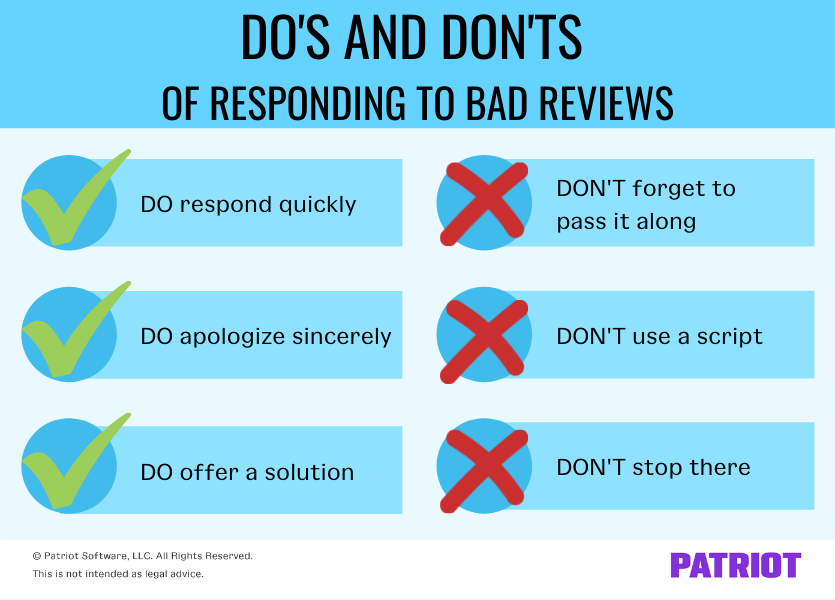Great. You got a negative online review that’s now readable by everyone—current and potential customers alike. Before hastily typing out a response you may regret later, learn how to respond to a bad review. You just may be able to turn the situation into a marketing opportunity and keep the disgruntled customer.
How to respond to a bad review: 3 Do’s and 3 Don’ts
When it comes to online reviews, people can be blunt—and harsh. You might be surprised, hurt, and angered by some of the words you read about your business. But before getting offended by what your frustrated customers or the “internet trolls” have to say, take a deep breath. Learning how to respond to a bad review can save you more heartache later on.
Whether you’re looking to learn how to respond to a negative review on Facebook or how to reply to negative Google reviews, get started with these do’s and don’ts.
Here are the do’s of responding to negative online reviews:
- Respond quickly
- Apologize with sincerity
- Offer a solution
And, here are the don’ts of crafting your customer review response:
- Forget to pass it along
- Use a script
- Stop there
Ready to dive in? Read on for the do’s (1 – 3) and don’ts (3 – 6) of responding to online reviews.

1. Do respond quickly
If you read reviews and forget to respond, you might be losing your opportunity to turn things around. The sooner you respond to the reviewer, the better your chance at retaining the customer. In fact, the clock starts when the reviewer leaves their review.
In many cases, the reviewer wants you to respond. They want to hear what you have to say about the situation and what you’re going to do about it. And, maybe they’re leaving the review as a last-ditch effort to get your attention (e.g., if your business hasn’t returned their calls).
Whatever the case may be, put aside time to respond quickly to reviews. The reviewer should understand if you don’t get back to them on a weekend or legal holiday.
But, the customer might not be so understanding if you take weeks to respond … or don’t respond at all.
On why responding quickly is so important in business, John Li, Co-Founder and CTO of Fig Loans, says:
If you can address the customer’s concerns and settle on an amicable resolution, they might retract or rewrite their review. It’s always best to take action as soon as possible in order to prevent it from causing long-term damage to your brand reputation.”
So, show the customer (and other readers) that you genuinely care about each negative review and experience by responding quickly.
2. Do apologize with sincerity
What should the star of your bad review response be? The apology. Your sincere apology for the customer’s poor experience with your business should be the heart and soul of your response.
Before writing your apology, start by:
- Putting your pride aside
- Being empathetic (aka really put yourself into the customer’s shoes)
- Taking responsibility for the problem (e.g., “We’re truly sorry to hear about your experience with us—we’re disappointed, too.”)
Apologizing to the customer can help you ease into a tense situation and lay the groundwork for making things right.
Not your fault?
Maybe you’re reading a review from someone you’ve never spoken with or seen before. Or, maybe you’re reading a negative customer review from someone who is the one at fault.
Whatever the situation, the last thing you want to do is pass the blame. Brian Turner, CTO of ConvertBinary, speaks more on this:
If you start accusing the customer of lying, or disparaging the statements that they’ve made, it’s going to reflect poorly on you when other prospective customers check out your reviews before making a purchase. People want to see maturity—it inspires confidence, and makes it easier to rationalize buying your product or service.”
Instead of passing the blame, thank the customer for taking the time to leave a review. And, you might consider still apologizing for the experience they believe is associated with your business—even if it’s not your fault.
You might shift the apology to something more along the lines of:
- “We’re sorry to hear about your bad experience, but we are having trouble finding your order in our system—are you sure you have the right company?”
- “We’re sorry to hear about your bad experience—this is not typical of the customer service experience our customers rave about.”
- “I apologize for the confusion—have you tried XYZ?”
Whether it’s your fault or not, skip the blame game. Construct your response with grace (and the right word choices) to avoid escalating the situation.
3. Do offer a solution
Apologizing is essential when it comes to how to respond to a bad review. But when it comes to learning how to reply to bad reviews, the solution is also a star part of your response.
Offering the disgruntled customer a solution can make the difference between gaining and losing the reviewer and a future customer reading the review. Sometimes, people don’t care why something happened—they just want to know how to fix it.
So, you need to be willing to let the reviewer know how you’re going to fix the problem or make it up to them. For example, your solution might be to:
- Talk further with them to learn more about the problem
- Give them a solution to fix their issue
- Offer a discount on the good or service
- Give the reviewer a future discount or free item
- Expedite product shipment
4. Don’t forget to pass it along
Do you let negative comments hang out in limbo? Or, do you pass along the feedback to your team? Don’t do the former. Remember to jot down what customers have to say to make business improvements.
Show customers you’re listening to what they have to say by letting them know that you’re going to share their feedback with your employees. Let them know that you’re listening to them, even if you can’t do anything except write down their comments and concerns.
In the future, you can let the customer know if you fixed the problem (e.g., added a new feature to your product). That way, you might be able to bring the customer back. If the customer doesn’t want to come back, no worries—you can rest assured that other customers won’t have the same issue.
5. Don’t use a script
Blah, blah, blah. The customer who left the review (and everyone else reading said review and response) doesn’t want to hear the same thing over and over again…
…Which is why it’s time to ditch the script. Sure, you can follow a similar template if you get into a groove that works for you. But, be sure to:
- Use the customer’s name
- Tailor your response to the reviewer’s specific issue
- Avoid saying the same exact thing to each person
- Consider adding the responder’s first name
Take the time to manually write up a message to each negative (and positive) review you receive. Personalizing your responses could help you change things around for your reviewer and show other readers that you truly care.
Ditching the script could be a win-win-win for you, the disgruntled customer, and future customers.
6. Don’t stop there
Think the conversation ends here? Think again. Part of knowing how to respond to a bad review includes reaching out personally to the customer.
After showing sympathy, acknowledging the problem, and addressing the customer’s concerns, Jason Butcher, CEO of CoinPayments, suggests to:
Try to take the situation offline. This is a good practice in case things get out of hand. You want to limit the amount of negative exposure you have online, and taking the situation offline will help eliminate this problem. Once the situation is off the public view, try your best to resolve the issue and maintain the customer relationship.”
By talking directly to the reviewer in private, you can further work to:
- Resolve the issue
- Save the relationship
- Learn from the situation
- Make changes
In your review response, you can let the reviewer know that you or a member of your staff will be reaching out to them to learn more. Then, follow through on your word—either call or email the customer if you have that information available.
If you don’t have the individual’s contact information, ask them to provide you with it privately (e.g., by sending you a Facebook message).
When talking privately and directly with the customer, do what you can to resolve the issue and keep the customer, if applicable.
This is not intended as legal advice; for more information, please click here.



